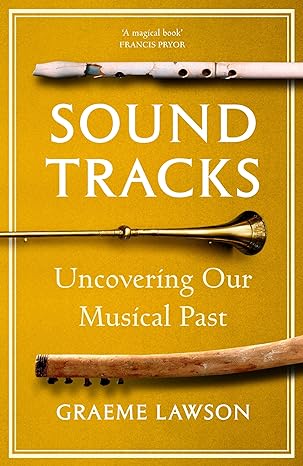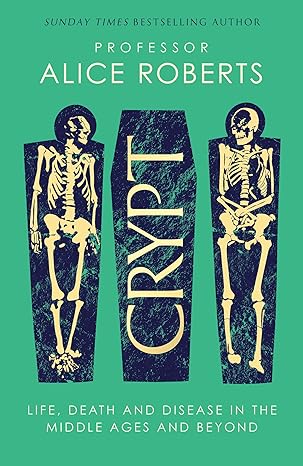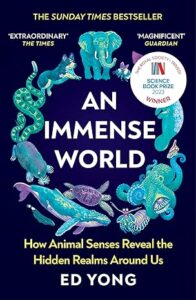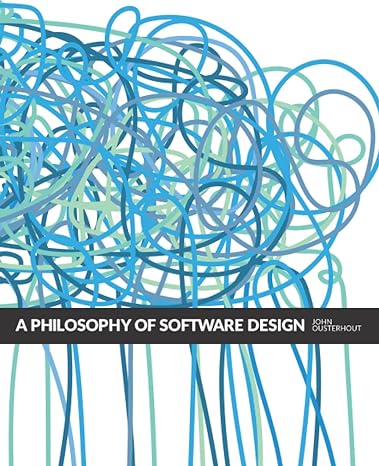This is a review of Sound Tracks: Uncovering Our Musical Past by Graeme Lawson, a history of musical instruments discovered through their archaeological remains. Unusually for a book such as this the action takes place in reverse, starting from the present day and finishing several million years ago. Also unusually the chapters are very short, typically less than 10 pages. Chapters are grouped into 12 chronological periods. Each chapter introduces an object, or a few objects and discusses a wider issue prompted by the object. Issues may be something like the discovery of a music shop in medieval Oxford and how it is identified from court records relating to crimes (counterfeiting) committed by the owner, how different materials are preserved, or how an instrument has developed. Although unusual I liked this style, I thought it would work quite well for history lessons. It means my usual note taking process was modified, rather than writing notes on individual pages, I read a whole chapter and wrote notes on that.
It is a fair sized book running to 50 or so (short) chapters.
Sound Tracks is focussed on archaeological finds, in terms of quantity the most finds are small, ubiquitous instruments with metal, bone or ceramic components which means things like harmonicas, mouth harps, small whistles/flutes and the metal tuning pegs of instruments like harps. These items are found as discards but not commonly. Musical instruments are also found as grave goods. However, they are not as common as finds like weapons or jewellery – unsurprisingly since few are so committed to music that they would take their instruments to the grave.
Musical instruments are also found as “sacrificial” items – sound and often valuable items which have been systematically broken or destroyed are common in archaeology – what is not clear is the “why” of such breakages.
The oldest stringed instruments, dating back to 3000BC, found in Ur in Iraq were discovered because an archaeologist spotted several interesting looking voids in a tomb they were excavating and decided to fill them with plaster of Paris. They turned out to be lyres, and their approach meant the structure of the instruments were fantastically well preserved. Even in high status graves and tombs preservation is the exception rather than the rule.
Somewhat to my surprise shipwrecks are sites of sometimes remarkable preservation in musical instruments. In the right conditions artefacts will quickly be buried by anoxic sediments which gives excellent preservation – in fact on one shipwreck written musical notes were found (although the paper on which they sat had decayed away). Lawson cites violins recovered from the Kronan in Sweden (sunk 1676) and the Mary Rose (sunk in 1545). These examples show the effect of standardisation on instrument design often fine instruments are upgraded as fashions change. In some cases instruments from shipwrecks even preserve use patterns – showing what notes were commonly played. Related to shipwrecks, Lawson also talks about whistles and trumpets used not for music but for communication and command.
A recurring theme is that instruments often appear in the archaeological record “fully-formed”, that is the earliest examples found are fully-functional and sophisticated. The cause of this might be illustrated by the development of steel drums in Trinidad, this process started in the 1930s when the colonial authorities banned the traditional bamboo drums – in no more than 20 years the steel drum was fully formed in design. So musical innovation can happen in the blink of an eye. Furthermore, experiments in musical design are not preserved – at best their components will be reused, and at worst used as firewood. Pipes/flutes with evidence of deliberate, consistent tuning have been found dating back 40,000 years.
I was intrigued to learn that the earliest keyboard instruments were Roman pipe organs dating back 1700 years, this illustrates another feature of the archaeological record – the key specimen of Roman pipe organs was found in Hungary rather than back home in Rome. In another case, the understanding of Greek lyres was advanced by the discovery of a “bridge” on the Isle of Skye, in North West Scotland.
Musical instruments can represent incredibly advanced technology. For example, a chapter is dedicated to casting church bells in situ by digging a large pit at the host church, another to a carnyx from the late Iron Age, another to a carillon of 64 tuned bells from a Chinese tomb (dating back to the 5th century BC). There are numerous well-crafted tubes forming flute/wind instruments. Lawson is an experimental archaeologist, so has experience in trying to reconstruct these instruments – it is not easy, or without risk – one researcher died from inhaling toxic yew wood dust, another from trying to play his reconstructed instrument – he blew too hard!
Writing music is a bit outside the remit of this book because it is largely a historical exercise rather than an archaeological one although Lawson mentions some musical graffiti and the earliest example of lyrics and musical notation together found on a clay tablet dating back to 1300BC in Syria. This also touches on the theme of the relationship between poetry and music. There is some evidence that epic poems like Beowulf were performed with musical accompaniment.
The book finishes with a couple of chapters on what music might have existed in the deep past on the basis on human biology, genetics and cave art. The oldest wooden artefacts recovered date back 300,000 so there is a slim chance of discovering musical instruments back to this time.
I really enjoyed this book, the short chapters worked very well for me and I’m interested in music.





